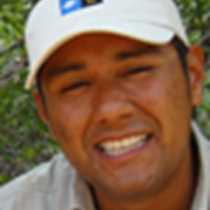Bartolomé & Santiago
This morning we had an early walk on the island of Bartolomé. This island is a small formation located in the southeastern part of Santiago. This place is also known as an open book of the exceptional geology of the Galápagos which demonstrates the main force of the creation in this archipelago. The force of volcanism for several million years has been responsible of the different irregularities that allow our endemic species to survive in very little places with unique conditions. Those conditions have been changing continuously and making some species adapt to the changes.
On Bartolomé we are always observing the small amount of species of plants, like the tiquilia and the lava cactus, that found a unique place with no competition to survive, but also with small chance of absorbing nutrients and water available in certain seasons. Those are the pioneer plants that make this place different than some other oceanic Islands.
We started the hike at 6:30am. With a lot of effort we climbed the impressive 375 steps to the top of the volcano, but that effort is worth everything once you get up there. An incredible view of the rest of the Galápagos waited for us. Even the Marchena Island was possible to observe at the north; also nameless rock at the south was easily spotted.
We came back to the National Geographic Islander after an hour and a half of intense exercise to recover lost calories, and then we got ready to have a chance for our first snorkeling in the Galápagos. The beach of Bartolomé was a great place to begin, giving us the opportunity to decide if is was better to stay on shore or just to go for the deep water snorkel by ourselves. The water was clear and warm for the usual temperatures at this place.
Penguins are found in the south regions, but here we saw Galápagos penguins which are the only ones found swimming into mangroves areas. Isn’t that amazing! Our naturalist Celso found a huge female marble stingray, an unusual sized animal who is a relative parent of the ancient sharks. And I almost forgot to mention the 7 foot long white tip reef sharks that rested at the bottom while some of our friends practiced free diving to take some pictures of him. This is a rare species that doesn’t need to swim the whole life to keep breathing like the black tip sharks. They are animals that prefer to hunt at night and that is why they don’t really move during the day time.
In the afternoon we visited Santiago Island, which is an amazing place that shows what a medium age island of the Galápagos looks like after a few million years. There are some interesting migratory shore birds that arrived a long time ago and decided to make this place their home. They lost the fear against some predators and we can stand 2 feet away and they will never move. This is the case of the American oyster catcher.
Some of us decided to kayak along the shores of James Bay and others preferred to swim from the magical black volcanic beach. After one hour we walked along the coast to listen about the human history and eradication projects of introduced animals on this island. Also, the Galápagos fur seals were at the end of this walk in small groups. Some of us came back to the ship at 6:30pm because there was a lot of enthusiasm to see every last detail of nature.



